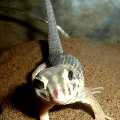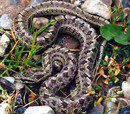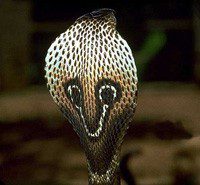
Tiger snake
The tiger snake (Notechis scutatus) is one of the brightest representatives of the snake family. Although it is inferior in size to the taipan, reaching only 1,5-2 m in length, the poison of this snake is very strong. Herpetologists believe that of all land snakes, the tiger snake has the strongest venom. This large Australian snake takes the 5th place in the list of the most poisonous snakes in the world, small animals bitten by it die immediately. Due to the fact that representatives of this species are widespread throughout almost the entire Australian mainland (except for the city of Darwin and areas to the north of it), it is much more dangerous than the rare taipan. Tiger snakes can also be found in Tasmania and on some islands off the south coast.
Contents
Classification
 Kingdom: Animalia (animals).
Kingdom: Animalia (animals).
Subkingdom: Eumetazoa (multicellular, or eumetazoans).
Section: Bilateria (bilateral, or bilaterally symmetrical).
Supertype: Deuterostomia (deuterostome).
Type: Chordata (chordates).
Subtype: Vertebrata (vertebrates).
Infratype: Gnathostomata (jaws).
Superclass: Tetrapoda (quadrupeds).
Class: Reptilia (reptiles, or reptiles).
Subclass: Diapsida (diapsida).
Infraclass: Lepidosauromorpha
Superorder: Lepidosauria (lepidosaurs).
Order: Squamata (scaly).
Suborder: Serpentes (snakes).
Family: Elapidae (aspididae).
Genus: Notechis (tiger snakes).
Species: Notechis scutatus (tiger snake).
Inhabitation
Tiger snakes can be found in almost the entire territory of Australia, including the state of Victoria, the southern regions of Queensland and the east coast of New South Wales, except perhaps for the city of Darwin and the northernmost regions. Also, representatives of this species inhabit Tasmania and some islands off the southern coast. You can even find tiger snakes in New Guinea.
Representatives of this species were met by the indigenous inhabitants of Australia in the territories of coastal regions, wetlands and streams. In prey-rich areas, quite large populations of tiger snakes can be found.
Description
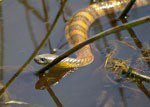 Regardless of its range and subspecies, the tiger snake remains a very dangerous predator due to its size and venom strength. Although this snake is inferior in size and toxicity to the taipan, its length reaches up to 2 meters in some representatives, and the poison is the strongest neuro and myotoxin. Herpetologists believe that of all land snakes, it is the tiger snake that has the strongest poison. This large Australian snake ranks 5th in the list of the most venomous snakes in the world, small animals bitten by it die immediately, and a person does not live long without the introduction of polyvalent serum. According to Australian herpetologists, the glands of a particularly large tiger snake have enough venom to kill 400 people.
Regardless of its range and subspecies, the tiger snake remains a very dangerous predator due to its size and venom strength. Although this snake is inferior in size and toxicity to the taipan, its length reaches up to 2 meters in some representatives, and the poison is the strongest neuro and myotoxin. Herpetologists believe that of all land snakes, it is the tiger snake that has the strongest poison. This large Australian snake ranks 5th in the list of the most venomous snakes in the world, small animals bitten by it die immediately, and a person does not live long without the introduction of polyvalent serum. According to Australian herpetologists, the glands of a particularly large tiger snake have enough venom to kill 400 people.
The tiger snake leads a predominantly diurnal lifestyle, and spends most of the day in motionless waiting. It is very easy to miss it in the grass or confuse it with a tree branch. However, those who consider them slow and sleepy are deeply mistaken – if necessary, a tiger snake is capable of a lightning-fast reaction. Although it rarely attacks people first, it does not crawl into human habitations and generally tries to stay away from people.
The color of representatives of the species Notechis scutatus depends on the habitat and subspecies and can be extremely diverse. The body of tiger snakes can be gray, black, dark brown, green or olive, and there are both monophonic specimens and those intercepted by unsharp golden rings. The belly of these snakes is usually lighter than the back and is colored yellow, turning black towards the tail. This coloration resembles a tiger, hence the name.
On the upper shortened jaw, representatives of this species have two fixed poisonous teeth, bent inward. They have special grooves for poison, which in most snakes are closed and form tubes that are hollow inside. Around the venom gland in tiger snakes is a muscle that presses on the gland during a snake bite. Because of this, poison is squeezed out, which then enters the victim’s body through the grooves of the teeth when bitten.
Due to the small length of the teeth of all aspid snakes, bite wounds are difficult to notice immediately, especially if the lower limbs were injured or the snake did not bite, but only scratched the victim. Pain from tiger snake bites is rare. When poison enters the body, drowsiness, headache, sometimes loss of consciousness, vomiting and paralytic symptoms are immediately noted. Necrosis, bleeding and swelling are rare. Soon comes paralysis of the respiratory center, cardiac arrest and death. With “dry” bites (without the introduction of poison), there may be no clinical symptoms at all.
Food
 Under natural conditions, the nutrition of tiger snakes depends on their habitat and subspecies. Tiger snakes living in the west of Australia are distinguished by a small head on a large body and, accordingly, have a small jaw. Therefore, their main diet includes frogs, toads, tadpoles, small rodents, medium-sized birds and eggs of birds that live in low-growing branches of trees and shrubs. In addition, tiger snakes do not disdain fish, including eels in their diet. Representatives of subspecies living closer to the north of the mainland are slightly larger in size and have a more massive jaw. These snakes prey on larger prey, such as seagulls.
Under natural conditions, the nutrition of tiger snakes depends on their habitat and subspecies. Tiger snakes living in the west of Australia are distinguished by a small head on a large body and, accordingly, have a small jaw. Therefore, their main diet includes frogs, toads, tadpoles, small rodents, medium-sized birds and eggs of birds that live in low-growing branches of trees and shrubs. In addition, tiger snakes do not disdain fish, including eels in their diet. Representatives of subspecies living closer to the north of the mainland are slightly larger in size and have a more massive jaw. These snakes prey on larger prey, such as seagulls.
Although this tiger snake is mainly diurnal, it can also be encountered on warm evenings or nights – they tolerate low temperatures fairly well. However, these snakes rarely attack people, only when they defend their territory.
Reproduction
The tiger snake is an ovoviviparous species of snake. Such snakes do not lay eggs, but give birth to live kites. On average, there are 12 to 14 cubs in a litter. Once, at an autopsy, hunters found as many as 64 embryos in a large female tiger snake.
Additionally
 A case was recorded when 109 embryos were found in a large female at autopsy.
A case was recorded when 109 embryos were found in a large female at autopsy.
Despite the fact that the tiger snake is the most poisonous, locals say that it is also the most cowardly: it never crawls into houses, tries to stay away from people and attacks only in case of protection.
Catchers of snakes sometimes specially breed them on small uninhabited islands for the sake of valuable poison. According to herpetologists, the glands of a particularly large tiger snake have enough venom to kill 400 people.
These snakes are ovoviviparous, with an average litter of 12-14 young. Once, a large female tiger snake, during an autopsy, found as many as 64 embryos.
Sources of
http://www.floranimal.ru/
http://www.alins.ru/
http://www.reptilia-club.ru
http://www.bojtes-zveri.ru
http://petland.org.ua
http://log-in.ru/
http://bridjarnja.narod.ru/
http://en.wikipedia.org/
Other names
Тигровая змея, The tiger snake, Australian tiger snake, Mainland tiger snake, Eastern tiger snake, Ostliche Tigerotter.
Subspecies
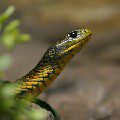 Currently, most herpetologists consider the species Notechis scutatus (tiger snake) monospecific, but some still divide them into several subspecies, different in color, size and habitat.
Currently, most herpetologists consider the species Notechis scutatus (tiger snake) monospecific, but some still divide them into several subspecies, different in color, size and habitat.
The common tiger snake has a flat, blunt head on a large body. The bodies may flatten along their entire length when the snake is agitated or trying to keep warm. The average length is 0.9 m, the maximum length is 1.2 m, but common tiger snakes up to 2.0 m long have been recorded. The color can be quite different, but the main colors are brown, olive, green with thin stripes of light yellow. Sometimes there are specimens without stripes.
The western tiger snake grows up to 2m in length on average. She has a disproportionately small head in relation to her large body, and the color is very noticeable: steel blue or black with or without bright yellow stripes. The ventral surface is usually yellow, but closer to the tail, the scales on the belly of the western tiger snake turn black.
The Mount Chapell Island tiger snake is one of the largest subspecies of Notechis scutatus. Its size averages 1.9 m in length, and some representatives grow more than 2 m. Their dorsal scales are usually bicolor (greenish-brown with black), sometimes thin stripes come across. The scales on the belly are usually lighter than the dorsal. These snakes are quite docile.
Tiger snakes from King Island and Tasmania are quite small compared to other subspecies, they grow to only 1 m in length. Moreover, the cubs are usually thin and grow slowly. Dorsal scales can be jet black with thin stripes, gray with black spots, or solid black, gray, or brown. The scales on the belly are slightly lighter than the dorsal. Tasmanian tiger snakes are the calmest and slowest snakes, probably due to the fact that they live in cool climates.
The peninsular tiger snake is the smallest subspecies, with an average length of only 1.1 m, and in island specimens even less – 0.86 m. The dorsal scales are jet black, sometimes with white or cream marks around the mouth. Usually the scales on the belly are dark gray with black. On the island of Kangaroo, there are very diversely colored specimens, often of a uniform brown color with a red belly.
Content
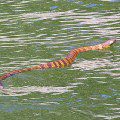 Even experienced herpetologists do not risk having poisonous snakes at home, especially dangerous ones like a tiger snake. Due to its calm nature and sedentary lifestyle, the illusion of safety is created, but this snake remains an extremely dangerous creature. To maintain it, you need an empty bright room without gaps, a sealed terrarium, a thermometer, a hygrometer, a UV lamp and a set of special tools for feeding, processing and transportation. First of all, you need to have a polyvalent antidote serum for the venom of Australian snakes on hand. Emergency medical care for a tiger snake bite will not help, because in Russian hospitals there is no antidote even for the poison of the gyurza and cobra. In addition, the serum must be administered immediately, within 3 minutes after the bite, otherwise it will be too late.
Even experienced herpetologists do not risk having poisonous snakes at home, especially dangerous ones like a tiger snake. Due to its calm nature and sedentary lifestyle, the illusion of safety is created, but this snake remains an extremely dangerous creature. To maintain it, you need an empty bright room without gaps, a sealed terrarium, a thermometer, a hygrometer, a UV lamp and a set of special tools for feeding, processing and transportation. First of all, you need to have a polyvalent antidote serum for the venom of Australian snakes on hand. Emergency medical care for a tiger snake bite will not help, because in Russian hospitals there is no antidote even for the poison of the gyurza and cobra. In addition, the serum must be administered immediately, within 3 minutes after the bite, otherwise it will be too late.
Additionally
Despite the fact that the tiger snake is the most poisonous land snake in Australia, the locals consider it also the most cowardly: it never crawls into human dwellings and generally tries to stay as far away from people as possible, attacking only in case of protection of territory or life.



